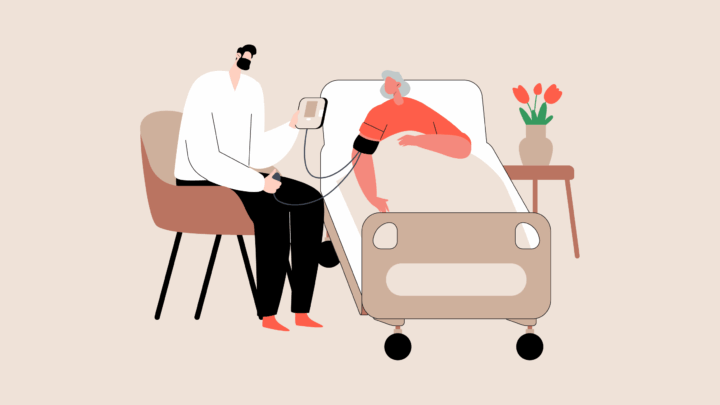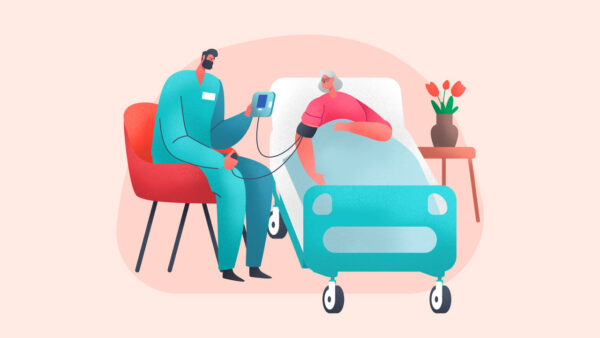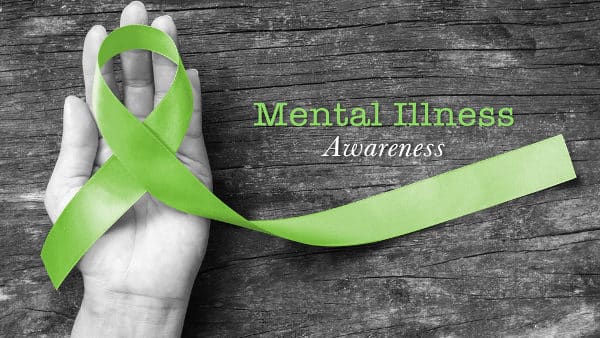
Trust and rapport are two vital aspects of a positive doctor-patient relationship. Both have a direct impact on adherence to treatment, access to care, and overall patient satisfaction. Building trust is a process that requires effective communication, active listening, empathy, and a collaborative approach where patients not only feel comfortable but also feel heard and respected.
Rapport is a slightly different type of process, one that is built upon open communication, shared decision-making, and mutual understanding. All communication requires clear and concise explanations, and through active listening, physicians should pay close attention to what the patient says, responding thoughtfully while demonstrating empathy and respect. Physicians and nurses alike should always focus on shared goals and self-awareness.
When it comes to building rapport, a physician on Sermo says, “Healthy boundaries are key. Also, setting clear expectations with your patients about what you expect from them as a partner in their care plan. Give yourself grace. Talk with your patients about non-medical stuff (I like your shirt, what does this tattoo mean?, etc).”
What is patient rapport?
Rapport is defined as a “harmonious relationship” and relates to collaboration and consistency between physicians and patients, and the need is pressing. Quality care depends closely on the connection with patients, and according to a 2021 article published in the journal JMIR Research Protocols, the foundation of that connection is based on qualities such as empathy, acceptance, respect, and a commitment to engage. Physicians need to deeply foster patient rapport, as it increases the value of care that is provided.
What are the 3 C’s of rapport building?
When healthcare providers build rapport with patients, they need to concentrate on the 3 Cs. By knowing these principles, doctors and nurses can strive for better rapport and offer more experiences of connection, communication, and empathy to people who are at risk of social isolation.
Connecting – It is important for physicians to align their style of communication with that of the patient. This can include adjusting pace, tone, and even non-verbal cues like mirroring their posture. An internal medicine physician shares, “How I respond to a patient’s complaints regarding a condition or malady must be with a similar sentiment or given in much the same way he or she has related and revealed it to me.”
Commonality – Finding shared interests, values, or experiences is key. A physician should always ask questions about the patient’s background, hobbies, or work to help find these connections.
Clues – This involves paying attention to the other person’s body language, facial expressions, and verbal cues, all of which can provide insights into the patient’s mood, level of engagement, and understanding of the conversation.

Why patient rapport matters
Effective rapport is more important than many people may realize. There are numerous benefits, and strong relationships are built upon rapport, which is an essential step in providing a positive experience. 95% of surveyed doctors on Sermo agree that patients respond better when healthcare providers display empathy and compassion.
Improves patient trust
Good rapport enhances patient trust, making them more likely to be transparent about difficult issues. A physician on Sermo affirms, “I think that showing our human sides is essential to creating connections with our patients. Those connections foster a greater trust in the provider-patient relationship and contribute to better health overall.”
Enhances treatment adherence
Patients are more likely to adhere to treatment plans and follow instructions when they have a good rapport with their physician, which leads to better health outcomes. One GP shares in their experience, “While the traditional medical training model emphasizes professionalism and emotional detachment, it’s important to recognize that empathy can enhance patient care and adherence to treatment plans”
Boosts patient satisfaction
Having a strong rapport leads to increased patient satisfaction, reduced anxiety, and improved health outcomes. An Internal Medicine Physician on Sermo says that, “All things considered, medical care that besides being correct and professional, is also one that shows compassion and understanding, I believe will result in superior care that is more beneficial to the patient.”
Reduces medical errors
A good rapport fosters open communication, which helps to reduce medical errors and misunderstandings between patients and their healthcare providers.
Lowers malpractice risk
A positive relationship builds patient satisfaction and reduces the chances of patients feeling that their care was negligent or harmful, even if unintentional errors occur.
Eases difficult interactions
With trust, understanding, and open communication, good rapport can help ease difficult interactions. Patients tend to feel more comfortable sharing their perspectives, listening to different viewpoints, and constructively addressing disagreements.
Supports physician well-being
A strong physician-patient relationship helps reduce stress and may assist in preventing burnout for the physician.Improves long-term patient retention
A strong relationship allows providers to better understand the patient’s individual needs, preferences, and health history, enabling them to provide more tailored and effective care. The rapport builds loyalty and satisfaction, making patients more likely to return to the practice and recommend it to others.

Strategies to build a good rapport with patients
Every patient shares the need to be heard, understood, respected, and cared for. To meet all of these needs, below are some key strategies:
Understand cultural sensitivity
Cultural sensitivity in a doctor-patient relationship is vital, and it means acknowledging and respecting each person’s cultural background, beliefs, and practices.
Master active listening
Physicians must closely pay attention and be sensitive to what each person is telling them, noticing both verbal and non-verbal cues. Show interest by maintaining eye contact, nodding, and asking genuine questions. Only 1 in 3 (33%) surveyed doctors on Sermo are using active listening as a form of connecting with patients, demonstrating the need for more widespread adoption.
Apply effective communication techniques
Use plain language, avoid medical jargon, and explain things in a way that is easily understood by the patient. In a Sermo poll, 61% of doctors indicated that plain language was a technique they used to simplify medical explanations, along with providing visuals, using analogies, offering a written summary, and encouraging questions to enhance understanding. An Anesthesiologist on Sermo shares, “It is amazing how very simple communication in layman’s terms helps to alleviate fear amongst patients and families.”
Implement empathy in patient care
Remember that patients are sensitive to medical issues, and discussions can be hard. Make every effort to understand the patient’s perspective, feelings, and experiences. Show compassion and always acknowledge their concerns. In fact, 84% of physicians use empathetic touch in their practice frequently or at least occasionally, and 74% agree it improves patient experience by making them feel connected, cared about, and heard. According to a General Surgeon on Sermo, “I have always tried to be empathetic and treat patients the way I would like to be treated. Without a doubt, if the patient feels understood, it can improve their response to how to handle their health-illness and recovery process.”
Set boundaries with care
While you need to have a comfortable and trusting relationship, set and maintain professional boundaries carefully.
Create a healing environment
The practice environment must be comfortable, respectful, conducive to open communication, and most of all, healing by ensuring privacy and a sense of calm.
Avoid rushing the patient
Each patient is equally important, and they deserve enough time to communicate their concerns. Don’t rush through the appointment, and understand that some patients may have different communication styles, which means they might need more time to open up than others.
Involve the patient in their care
Ask the patient to tell you their concerns, wants, and needs, and engage them in discussions regarding treatment practices. Be sure to listen to their preferences and concerns, and involve them in treatment decisions.
Follow up and follow through
Physicians must be committed to each patient’s well-being and following up as well as following through is necessary. A trauma surgeon on Sermo says that “Communication, explanation, follow-up, and good care of the patient, doctor, and family all contribute to the relationship.”
The role of humor in building rapport with patients
Benefits of humor in healthcare
There’s a reason the age-old saying “laughter is the best medicine” is so popular. Humor has a healing effect and using it in a healthcare setting can be beneficial in several ways:
- Reduces stress and anxiety – Humor can help reduce nervousness and release common stress and anxiety.
- Breaks down barriers – Some patients may feel awkward in a medical setting, and humor can help break those barriers.
- Enhances patient trust – Humor allows for a connection between the patient and physician.
- Improves recall of information – By lightening the mood, the patient can more easily recall information.
- Boosts physician well-being – Physicians are busy, and they have stressful jobs. Humor can help with well-being and help combat physician burnout by making daily encounters more rewarding and less stressful.
When is it pertinent to use humor?
Of course, every healthcare practitioner must know the appropriate time to use humor in a healthcare setting. Doctors must always be tactful and sensitive. A good way is to start with some self-deprecating humor. Make fun of yourself a bit and see how the patient reacts. However, always maintain the proper boundaries and follow the patient’s lead. When done properly, the right humor can enhance the patient’s experience, however, it may not be appropriate to make jokes in certain situations, such as when you are discussing terminal illnesses, delivering certain life-changing news, or at the end of someone’s life. If you have started with light humor, and the patient is not following your lead, it is a sign that the humor is not pertinent, and it is time to be serious.
Join the conversation on Sermo
Remembering the key strategies to build rapport is a fundamental aspect of being a doctor and helps every patient to have a positive experience. It’s a skill every doctor should develop and refine through daily practice. Clear communication, genuine empathy, and consistent professionalism create bonds that last and every patient encounter is an opportunity to build trust and make a difference in someone’s life.
The Sermo community is a place where you can learn and share techniques and experiences about building rapport with other physicians. Connect with peers from around the world who are building rapport with patients and share your experiences. Create a free Sermo account today.















